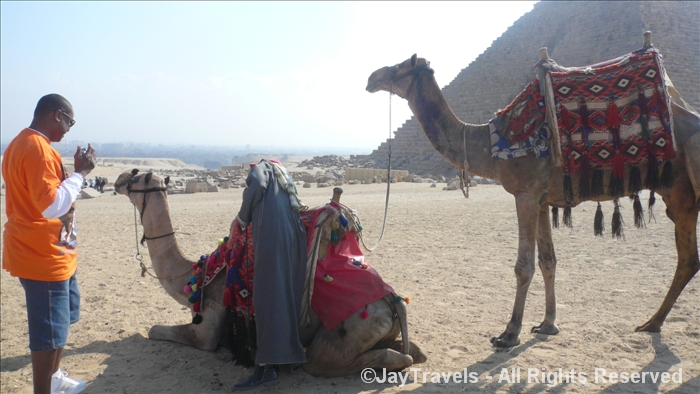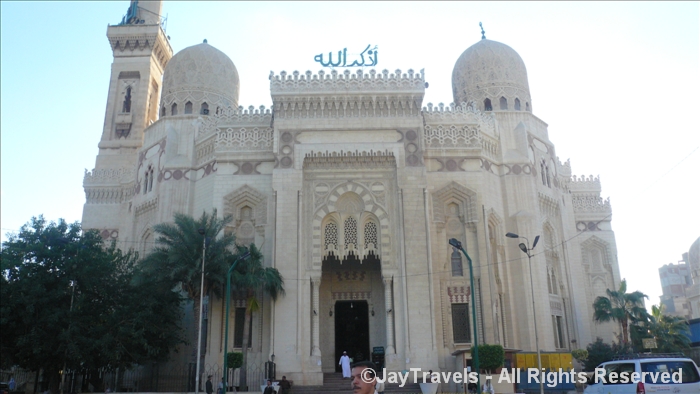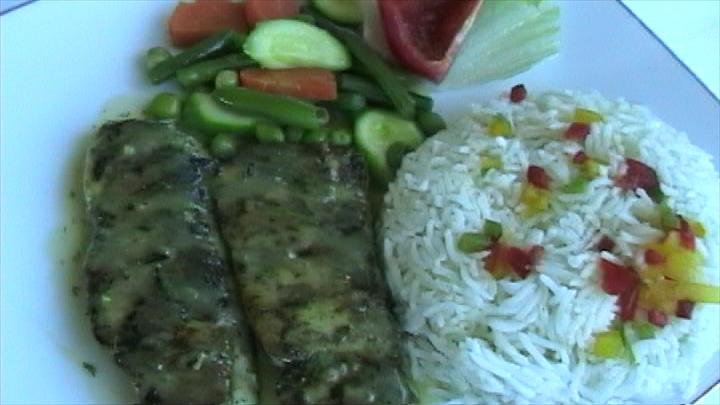The Great Pyramids & Sphinx
One of the 8 Wonders of the World, these ancient structures have been standing since 2600 BC. The first thing I learned is the Pyramids are in fact tombs. The Egyptians built the tombs to preserve the bodies of the Pharaohs until such time they would return to their earthly form. Because all of the jewels have long since been looted or moved to museums, there’s very little to see inside of the Pyramids themselves – just dark and cramped. Nevertheless, the sheer size and the fact that these things are still standing after such a long period of time is amazing.

Memphis & Necropolis
The original capital of Egypt, Memphis was the city that bound Upper and Lower Egypt. In present day, it is a home of a few artifacts from the Old Kingdom. The best of which is the giant statue of Pharaoh Ramesses II that sits in an open air museum. This statute is about 40ft long and in almost pristine condition. In fact, you have to climb two flights of stairs to actually see the entire structure. Not far from this site are the step pyramids and funerary complex of Djoser.
Alexandria

- Catacombs – A completely stone set of chambers used to house the tombs of post-ancient Egyptian monarchy. While not as intricate as the ancient Pharaohs tombs, it is a very interesting look at the mingling of Egyptian and European (Greek & Roman) burial rituals. Unfortunately, no pictures were allowed.
- Beach – Again, most people think of desert when they thing of Egypt. While there is certainly a lot of desert – a good 40% of the countries’ border is covered by water (Mediterranean & Red Seas and Nile River). In Alexandria, this means there are beaches as far as the eye can see – with the requisite hotels in the background. If not for the Arabic street signs, the places doesn’t look any different than Cancun, Mexico! And with 105 degree summer temperatures – the beach is necessity.
- Dictators Complex – This place is notable because of its sheer size – it takes up almost 5 miles. Originally built as the palace of one of the Egyptian rulers in the 1950s (Farouk I think) – it included a palace, shipyard, personal sport fields – even a railroad. After being forced out via a coup, the complex has been turned into a tourist playground – including several hotels, marina, etc.
- Citadel of Qaitbay – Probably the best site in Alexandria, this 15th century fort on the shores of the Mediterranean Sea served as the first line of defense against invading armies. It includes a communal area, prison rooms, and canon firing positions.
Luxor (Ancient Thebes)
If when you think about Egypt you envision a sand filed desert and ancient statues of Pharaohs long gone – you are thinking of Luxor. About 450 miles south of Cairo, Luxor has been described as the world’s greatest open air museum. I certainly can’t think of anything so vast and utterly amazing. A good deal of the monuments would give current day architects trouble producing.
- Getting There – There are three good ways to get to Luxor from Cairo – by plane, by river cruise on the Nile and the option I took – overnight sleeping train. The Overnight train was pretty cool as it allowed you to see the sights while sitting in a comfortable cabin. While the cabins didn’t have flat screen TVs and other Western amenities, they were private, had a bed and desk and included dinner. The train departs Cairo around 8pm – still enough sunlight in the summer months to get some good pictures as you leave the city. The train pulls into Luxor early in the morning. Not the most efficient method, but I would highly recommend the experience.
- Valley of the Kings and Queens – The Valley of the Kings is the larger of the two valleys that houses the tombs of former Egyptian Pharaohs (kings). There are over 60 ‘known’ tombs in this valley – many of which have over 20 chambers within a single tomb. As I mentioned earlier, the Egyptians believed in reincarnation – thus the Pharaohs were preserved and buried with most of their jewels. To ward off theft of these jewels, some of the chambers were booby trapped (think Indiana Jones). Whether booby trapped or not, the chambers and the tomb room themselves were covered in some of the most beautiful art work of the period. As the name implied, the Valley of the Queens is the smaller valley that has the tombs of the Queens and the Pharaohs off-spring – the most notable is Queen Nefertiti.
Luxor Temple – This place is off the chain. Seriously. It’s really just too amazing to describe but here are a few examples. The entryway to this temple has two enormous statues of King Ramesses II and his Queen. All around them are these huge – like 150ft tall huge – pillars that marked the cathedral sections. Also around of the remnants of these large columns of pointed stone – the tops of which were covered in Gold so that the Pharaohs could navigate at night using the reflection of the moon. Hundreds of small (4-5ft), medium (10-15ft) and large (30ft and up) litter the nearly 2 mile compound.
- Hidden Village – It’s not actually called the hidden village, but I can’t remember the name in Arabic. It is however exactly like it sounds – and entire village that was rediscovered by mistake. Part of the Luxor Temple, it was a small village just off the banks of the Nile. As Thebes fell as the epicenter of Egypt, the village itself was abandoned. As the centuries pasted, the village was covered in sand. Over a thousand years later, the conquering Muslim armies setup a church on top of the village – not even aware of what was 20ft beneath. During one of Egypt’s many sandstorms a cleric noticed a pointed ‘stone’ sticking out of the ground. This ‘point’ turned out to be the top of one of the village’s temples. A few years of excavation lead to the complete restoration of this village. If you look at the picture, your see the doorway to this church is 30ft in the air – proving the builders had no idea of what was beneath. Amazing.
Beggars
Overall, my travels throughout Egypt were extremely rewarding and enjoyable. If there was one thing that was a complete downer was the number of beggars throughout the country. No matter where you went, these people would try to sell you something or outright just ask for money. In many countries (US included), these types of people congregate around tourists areas – but not in Egypt. These MFs are everywhere – hotels, train stations, restaurants, as soon as you get off of the plane – everywhere! They have no shame and no problems following you as you walk to wherever you are going. Even though the security presence is on every corner – they can’t protect you from someone whose only crime is annoying the shit out of you. Just saying ’No’ doesn’t work – as our guide told us – “No is just the start of the conversation”. The only real way deal with them is to flat out ignore them and not make eye contact (imagine you are the pretty girl in the club). In Western culture, ignoring someone standing directly in your face is ultimate in rudeness – here it a necessity. Furthermore, they aren’t even offended – it’s on to the next person.
Food
Strangely enough, there really isn’t a concept of ‘authentic’ Egyptian food. Not really sure why, but the cuisine is actually Middle Eastern fare – not distinctively Egyptian. This means the menus consist of foods eaten across the region, such as Hummus (Chickpea dip/spread), Falafel (Fried Chickpea Patties), Pita Bread and some sort of Kabobs (Chicken, Seafood, or Beef). As Egypt is 80% Muslim, there are very few Pork dishes to be found in restaurants.
 Having said that, one thing that’s slightly different than many other Middle Eastern countries is Egypt’s proximity to seafood from the Mediterranean Sea and the Nile River. By far the best food I encountered in Egypt was the variety, freshness and preparation of local seafood. While in Alexandria (don’t remember restaurant name), the chef grilled several whole Sole caught just hours before. In Cairo, a restaurant moored along the Nile River called the Fish Market offers fresh fish by the pound. In this setup, all of the seafood is laid out on ice in front of you (over 20 varieties of fish & shellfish), you select the seafood you want and whether you want it grilled, steamed or fried. The chef weights the fish, cooks it and brings the seafood and whatever sides you want to your table. Very nice.
Having said that, one thing that’s slightly different than many other Middle Eastern countries is Egypt’s proximity to seafood from the Mediterranean Sea and the Nile River. By far the best food I encountered in Egypt was the variety, freshness and preparation of local seafood. While in Alexandria (don’t remember restaurant name), the chef grilled several whole Sole caught just hours before. In Cairo, a restaurant moored along the Nile River called the Fish Market offers fresh fish by the pound. In this setup, all of the seafood is laid out on ice in front of you (over 20 varieties of fish & shellfish), you select the seafood you want and whether you want it grilled, steamed or fried. The chef weights the fish, cooks it and brings the seafood and whatever sides you want to your table. Very nice.
In Closing
One of my best vacations, a wonderful new experience – worth visiting again. Frequently thought of as a desert country, I found this is far from the case. With water on over 40% of the Egyptian border, is home to some of the best seafood and sustains its number one export – cotton. I didn’t even get to see Aswan (further south from Luxor), cruise the Nile, cross the border into Israel (border currently closed), and partake in some of the best scuba diving in the world at Sharm el-Sheikh (Eastern coast in Red Sea). One of the few places where I felt like I’ve seen so much – and want to go back to see that much more.
Happy Travels








.JPG)








